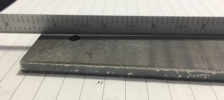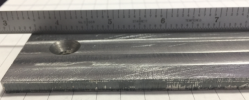Cushing H.
Gold Member
- Joined
- Jun 3, 2019
- Messages
- 2,714
though I probably should have realized this a number of months ago, I just had a rather unsettling revelation made obvious to me.....
As my grinding skills have progressed (hopefully...) I have continued to periodically struggle with getting a nice flat grind on my bevels (or at least flat enough to satisfy my) .... and have been somewhat surprised at the lack of flatness off of the grinder revealed when I have gone to hand sanding. Well ..... I have been gearing up to put a glass platen onto one of my metal platens, with the hope that it would reduce temperature and also help a little with the flatness issue.
WELL ..... thinking that ceramic is rather brittle, I thought I should use my newly obtained mini mill to "touch up" the platen so that the **brittle** glass platen was not resting on any low or high areas. So .... while doing that, I was REALLY surprised to find that there was quite a concavity from top to bottom on that platen (i.e. it was bowed so that the top and bottom protruded further out towards the surface that the belt rides on). After advancing, step by step, the endmill enough to produce a finally flat surface, I was REALL surprised to find that the difference between center and ends was at **least** 12 mils. The photo below is taken from the back-side of the platen (which had the same curvature, but I did not mill it) - the light shining through under the scale showing the gap:

the photo below is taken of the side that I did mill flat (showing no obvious gap):

Arrrrgggghhhhhhh. no WONDER I was struggling to get nice flat grinds - especially on FFG grinds on wider blades - which is the majority of what I do as I focus on culinary knives.
So .... I guess I mean this as a heads-up to all (myself included) to not assume that a platen is really all that flat - especially if you are grinding wide blades. I guess I will not be doing any significant bevel grinding until I get that ceramic platen installed :-(
As my grinding skills have progressed (hopefully...) I have continued to periodically struggle with getting a nice flat grind on my bevels (or at least flat enough to satisfy my) .... and have been somewhat surprised at the lack of flatness off of the grinder revealed when I have gone to hand sanding. Well ..... I have been gearing up to put a glass platen onto one of my metal platens, with the hope that it would reduce temperature and also help a little with the flatness issue.
WELL ..... thinking that ceramic is rather brittle, I thought I should use my newly obtained mini mill to "touch up" the platen so that the **brittle** glass platen was not resting on any low or high areas. So .... while doing that, I was REALLY surprised to find that there was quite a concavity from top to bottom on that platen (i.e. it was bowed so that the top and bottom protruded further out towards the surface that the belt rides on). After advancing, step by step, the endmill enough to produce a finally flat surface, I was REALL surprised to find that the difference between center and ends was at **least** 12 mils. The photo below is taken from the back-side of the platen (which had the same curvature, but I did not mill it) - the light shining through under the scale showing the gap:

the photo below is taken of the side that I did mill flat (showing no obvious gap):

Arrrrgggghhhhhhh. no WONDER I was struggling to get nice flat grinds - especially on FFG grinds on wider blades - which is the majority of what I do as I focus on culinary knives.
So .... I guess I mean this as a heads-up to all (myself included) to not assume that a platen is really all that flat - especially if you are grinding wide blades. I guess I will not be doing any significant bevel grinding until I get that ceramic platen installed :-(
